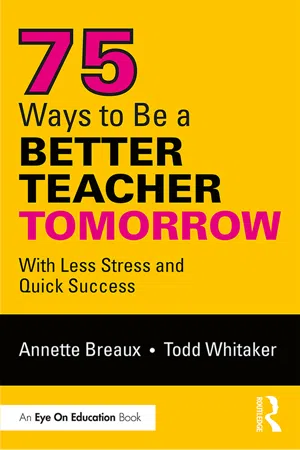
75 Ways to Be a Better Teacher Tomorrow
With Less Stress and Quick Success
- 152 pages
- English
- ePUB (mobile friendly)
- Available on iOS & Android
75 Ways to Be a Better Teacher Tomorrow
With Less Stress and Quick Success
About This Book
Highly effective teachers have something in common: They do simple things extraordinarily well—simple, uncomplicated things on a daily basis. In this new book by bestselling authors and presenters Annette Breaux and Todd Whitaker, you'll learn the secrets of these tried-and-true techniques that will help to improve your teaching, your students' learning, and your students' behavior. Annette and Todd, who have years of experience working in schools across the globe, reveal 75 easily-implemented strategies that will improve teaching and instruction, classroom management, student motivation, student achievement, parent communication, and more--with no new programs! Each tip provides practical takeaways that can be used immediately and with remarkable success.
Frequently asked questions
Information

Swallow Negative Words
What to Do
How and Why to Do It

Ask Yourself Five Questions
What to Do
How and Why to Do It
- Do the students know I care about each of them? (Students who doubt this are almost always causing problems in the classroom.)
- Do my students think that I am on their side? (Being “on their side” does not mean that you take their side even if they are misbehaving. It means you care about them, you support them, and you genuinely want what’s best for them. They need to know this, but we often neglect to convince them.)
- Do my students think that I love teaching?
- Do my students feel that they can succeed in my class? (A student who feels he/she can’t be successful will give up. Giving up leads to obvious problems.)
- Do I do all I can to make learning fun and interesting in my class?

Make One Lesson More Fun!
What to Do
How and Why to Do It

Learn One Important Thing About Each Student
What to Do
How and Why to Do It

Change the Expression on Your Face
What to Do
How and Why to Do It
Table of contents
- Cover
- Half Title
- Series page
- Title Page
- Copyright Page
- Table of Contents
- About the Authors
- Preface
- How to Use This Book
- Five Things This Book Will Do for You
- Five Things This Book Will NOT Do for You
- Reminder
- 1. Swallow Negative Words
- 2. Ask Yourself Five Questions
- 3. Make One Lesson More Fun!
- 4. Learn One Important Thing About Each Student
- 5. Change the Expression on Your Face
- 6. Leave One Compliment a Day
- 7. Ask for Student Feedback on a Lesson
- 8. Assign Two Purposes to Your Desk
- 9. Greet Every Student Every Day
- 10. Help Students to Follow Instructions
- 11. Never Miss a Birthday
- 12. Invite an Administrator to Your Room
- 13. Don’t Take Student Behavior Personally
- 14. Say Three Nice Things to the Student Who Aggravates You Most
- 15. Post a Simple Sign Telling Why You’re a Teacher
- 16. Have Students Create a Student Wall
- 17. Designate One Hour a Day for Paperwork
- 18. Give Stickers!
- 19. Speed Up the Slow Starters
- 20. Make Participation Less Stressful
- 21. Defuse a Negative Coworker
- 22. Befriend a New Teacher
- 23. Become Better Organized in 10 Minutes!
- 24. Get a Free Classroom Makeover
- 25. Try the “Have You Noticed” Trick
- 26. Shift Your Focus
- 27. Convince Your Students…
- 28. Know the Simple Dos and Don’ts of Social Media*
- 29. Get Free Ideas via Twitter
- 30. Compliment the Custodian
- 31. Ask for Student Feedback on Your Teaching
- 32. Sell What You’re Teaching!
- 33. Let Students Run a Project from Start to Finish
- 34. Use One Piece of Test Data to Improve Your Effectiveness
- 35. Act More Enthusiastic Than You Feel
- 36. Delegate Classroom Duties
- 37. Observe Other Teachers
- 38. Simplify Your Management Plan
- 39. Shorten Classroom Activities
- 40. Hold Classroom Raffles
- 41. Invite Outsiders In
- 42. Laugh with Your Students
- 43. Stop Trying to Be Perfect
- 44. Don’t Let Students Know When They Get to You
- 45. Call a Parent with Good News!
- 46. Become More “REAL” to Your Students
- 47. Keep Your Outside Struggles Outside of the Classroom
- 48. Ignore the Little Things
- 49. Meet with Students Individually
- 50. Brag About Your Students*
- 51. Act Like a Recruiter
- 52. Let the Emojis Speak
- 53. Participate in Students’ Lives
- 54. Be Available to Your Students
- 55. Help Students to Set Personal Goals
- 56. Display a Teacher’s Creed*
- 57. Make It Easy to Ask for Help
- 58. Reinvent Yourself Overnight!
- 59. Let the Games Begin!
- 60. Tell Students You Don’t Hold Grudges
- 61. Be the Most Professional Teacher in the School
- 62. Teach Students How to Think, Not What to Think
- 63. Make It Okay to Make a Mistake
- 64. Tell What You Like About Each Student
- 65. Give Students the Benefit of the Doubt
- 66. Teach Like a Great Coach
- 67. Give an Exit Ticket
- 68. Control Your Body Language
- 69. Determine the Origin of the Problem*
- 70. Send One Note, Per Class, Per Day
- 71. Keep Students Engaged from Bell to Bell
- 72. Shake Things Up!
- 73. Thank Students for Being in Your Class
- 74. Call Every Student by Name, Every Day
- 75. Channel Your Favorite Teacher
- Conclusion